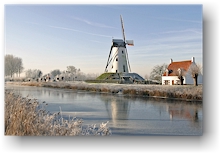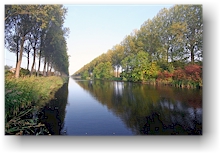|
» Bruges » Fort of Bavaria » Damme » Oostkerke » Hoeke » Sluis » Domain Ryckevelde » Leopoldcanal » Schipdonkcanal » NR town walls of Damme » NR fortress Saint-Donaas » NR Platte Kreek » Batreserve » Birdlife » NR Zwin |
Damse Vaart (Napoleonchannel or Canal Bruges-Sluis)
The Damse Vaart was dug on command of Napoleon (start in 1810). This is why it is sometimes also referred to as the Napoleonchannel. The digging was done by Spanish prisoners of war, "descendents" of the soldiers that ruled in the Netherlands no so long before. This channel was intended to be a part of a network of canals alongside the coast. This would enable the French army to move around much faster and to transport supplies much more rapidly since the French marine was not match for the English navy. The "Damse Vaart" was supposed to connect Bruges with the Scheldt, but that was never accomplished because of the loss of Napoleon in battle. The last piece between Hoeke and Sluis was only finished in 1856. In the meantime the evil had been done: Napoleon had the canal dug straight through the town of Damme with as consequence that a large portion of the town was demolished: the Corn Market and a number of stately mansions. The three waterways that merged in the centre of Damme (Lieve, Reie and Zwin) and the old harbour were filled up with the sand that was dug up for completing the "Damse Vaart". Als the last remains of Monnikenrede dissapeared under the canal. In the middle of the 19th century, the Leopoldcanal and the Schipdonkcanal were dug. They stream next to eachother on the territory of Damme and cross the Damse Vaart between Damme and Oostkerke. In order to make the Damse Vaart pass the other two canals, a system of siphons was used where the two canals passed under the Damse Vaart.
The canal is nowadays mainly known for its bicycle friendly character in the beautiful green polders. |
|
 Damme
became a great town due to its connection with the sea. This was not via
the Damse Vaart, as people do think sometimes. It's a widely spread
misunderstanding since the canal follows in great lines the bed of the old
Damme
became a great town due to its connection with the sea. This was not via
the Damse Vaart, as people do think sometimes. It's a widely spread
misunderstanding since the canal follows in great lines the bed of the old
 If
you want to know if there was navigation on the Damse Vaart, well there was.
Next to ships for supplying the villages next to the canal (coal, agricultural
products,...) there was also a so-called barge transporting people from
If
you want to know if there was navigation on the Damse Vaart, well there was.
Next to ships for supplying the villages next to the canal (coal, agricultural
products,...) there was also a so-called barge transporting people from
